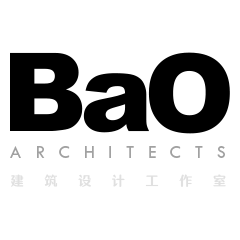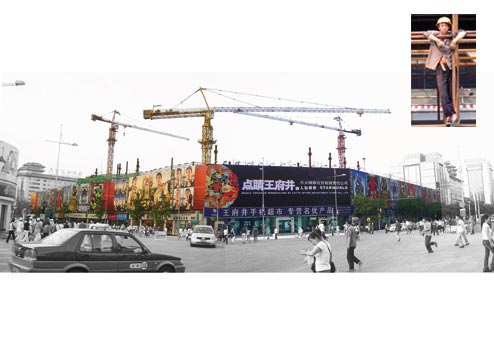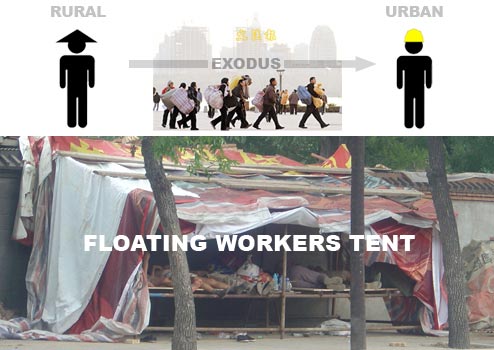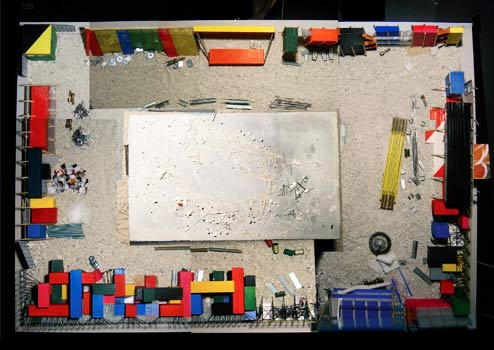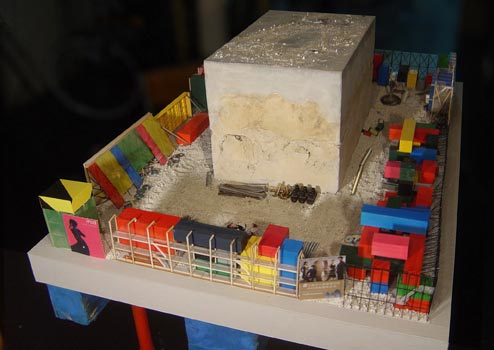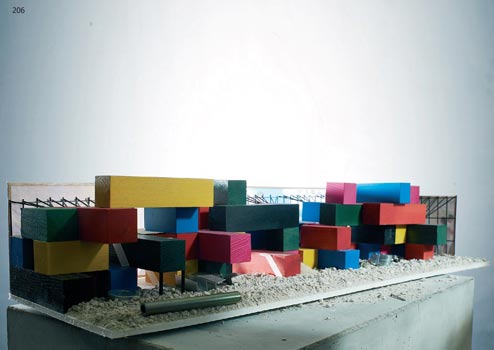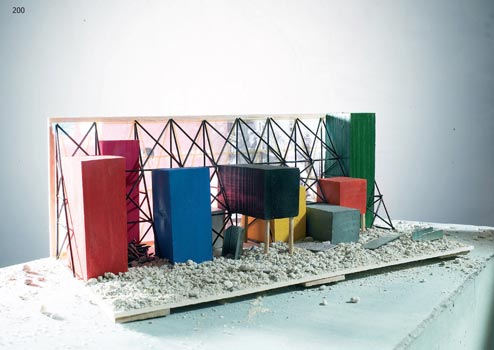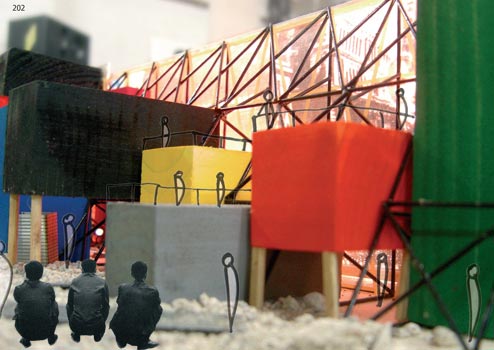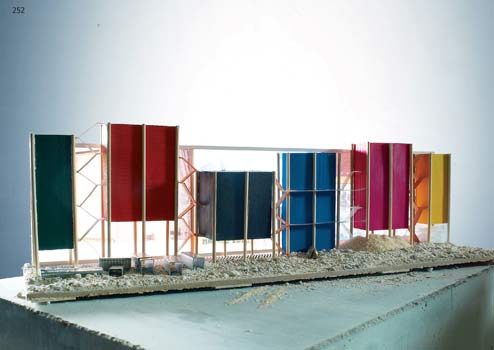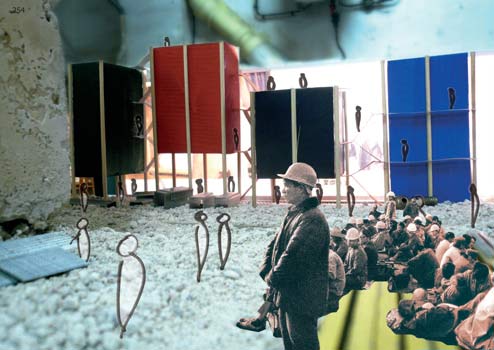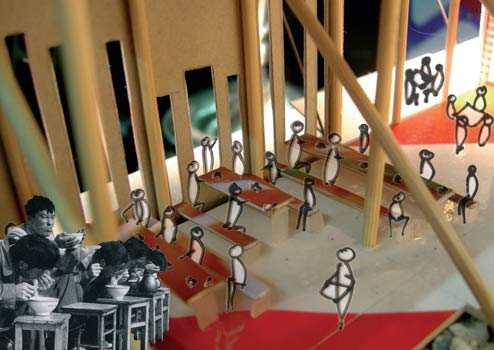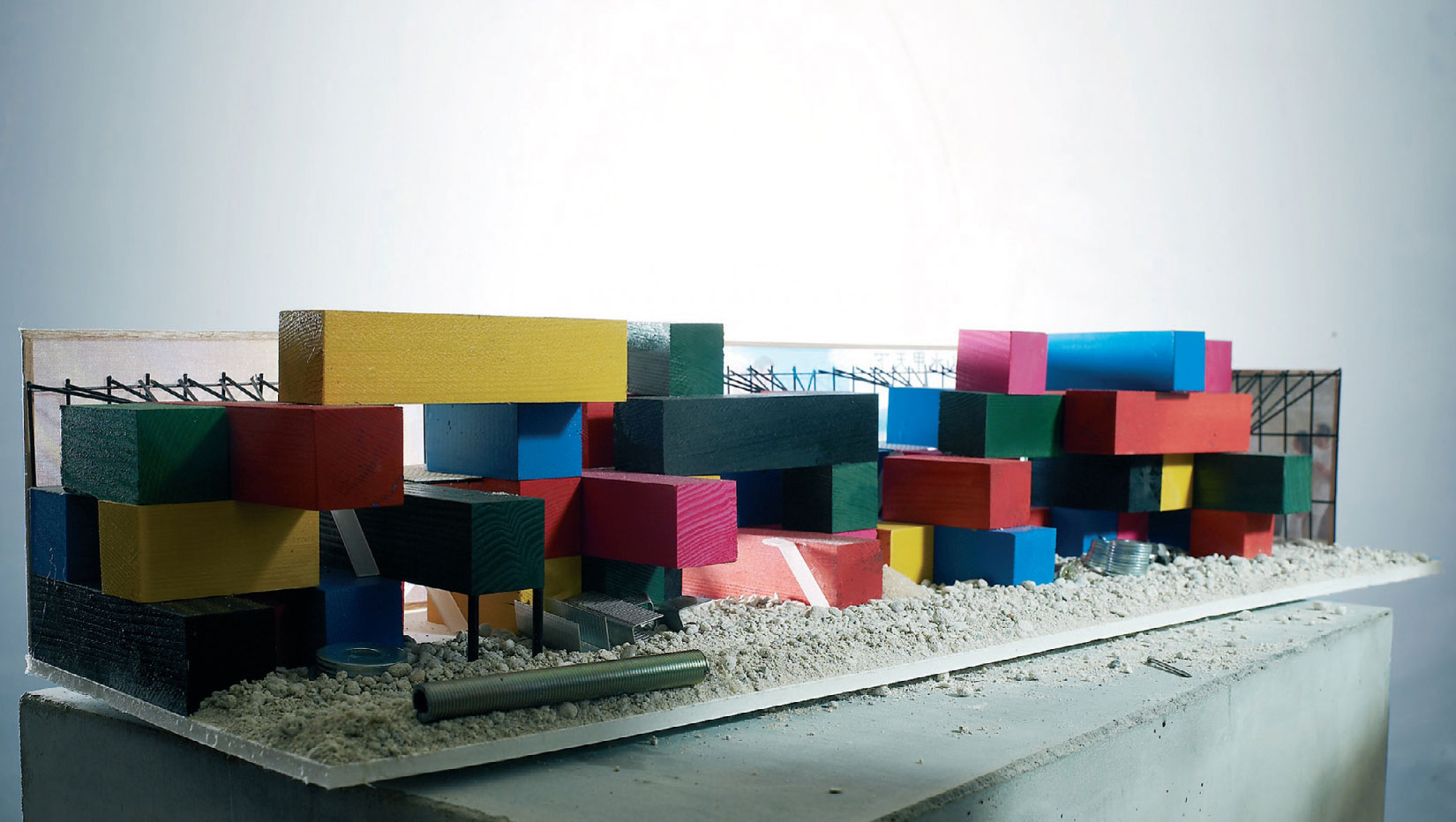

. . . ADblock . . .
ADblocksis an experiment on the ever-present construction sites billboards fencing. The basic scenario is a building site in which the artifact under construction is set in the middle of the lot. A model was built without pre-existing drawings in order to test organic and informal colonization of the peripheral advertisement structures. The billboards crown is composed of a juxtaposition of architectural experimentations illustrating the concept of billboards' hybridization. The subverted ADstructures shelter workers temporary housing, equipments, offices, Canteens, Storages that the construction site requires to function.
We tried in this quasi-symbolic closed city block (referring to autocratic modes of planning like danwei or microrayon), to inhabit on the limit, in the fringe, behind the decorum. The project explores this shearing moment of "in-betweeness" (edge, temporary, transforming) to advocate the qualities of an organic city growth. The model embodies the opposition between the formal, planned, building under construction and the temporary informal settlement on its fringe. Two scales (bigness/smallness), two materiality (concrete block/thin light structures), two positions (centre/ periphery), two systems (planned/unplanned), … two modes of thinking the city, one steril and one fertil.
:: Under construction ::
Contemporary cities are literally punctured by thousands of spaces under transformation. A perpetual destruction/construction movement is in action. The unquestionable consensus of the current development advocates a mechanical tabula rasa of the past. The whole country is obsessed by the idea of reconstructing a brand new modern China entirely devoted to the dogmas of newness, bigness, cleanness and consumption. The scale and the velocity of the Chinese economy leave no room for critical debates or reassessments of the notion of progress. We need everything and we need it now. 24 hours a day, cranes, trucks, welding machines, hammers, workers, are shaping the new Chinese dream and the modern metropolis features.
:: In between city ::
Past and present are sacrificed to the future. The present period is a one of transition; the cities of yesterday are disappearing and the cities of tomorrow are yet to come. The current urban landscape characterized by this notion of temporariness is colonized by the signs and the instruments of transformation. Green monoliths (anti-dust meshes covering the buildings under construction), cranes, machines, workers carrying 20m long concrete reinforcement bars, ruined districts where men are dismantling by hand the few leftover walls, have all become an integrated and assumed part of urbanity.
The city is a huge patchwork of realities. In less than 5 minutes, you can cross an old district, end up in a wrecked no-man's-land, go along a huge billboard behind which cranes and workers are pouring tones of concrete, cross a 5 lanes highway and arrives at the foot of a high-rise where golden boys, security guards and DVD vendors interweave without interacting. Extreme differences are acknowledged, contrasts are exacerbated, spaces are on the run.
:: In between population ::
Known as the floating people, the mingongs are the true actor of the Chinese development. More than 200 000 000 farmers decided to leave the countryside and go to the cities to find jobs with higher wages. The urban residence permit being quasi-impossible to get for farmers, they live in the cities in a kind of clandestine unstable situation. They have almost no rights and are treated as a second zone population. There are basically 3 options for them to get an accommodation: hostels (cheap dorms in the city), temporary structures given by the employers and, because of the shortage of both these options, tents or temporary self-made shelters built on the construction site. The extreme precarious situation, the lack of proper sanitary conditions and the clear disrespect for the "floaters" whose hands are shaping Chinese urban future are alarming.
"The working hand makes the pride of the nation" _Papa Allioum
:: (Bill)boarderline ::
Billboards are used as temporary bounding walls permitting to close and define the construction area and to hide the in-between transformative process of space while enabling advertisements to be displayed on the outskirt. These vertical surfaces are enclosing a whole set of temporary structures (cranes, stocks, building materials and tools, workers housing, generators, offices, etc…).
The huge steel frame structures that are needed to hold and cross-brace the billboard are wasting a lot of space, energy and potential. They could be reactivated and combined with useful programs in order to gain more spatial efficiency and give proper living conditions to the workers. The companies paying to have their advertisement displayed on these billboards would actually be indirectly sponsoring the accommodation of the workers and balance the investment of the employers. With a minimal architectural subversion, the billboard could embed living, stocking, technical or working spaces and become a relevant infrastructure for the construction site.
The ADblocks are experimental attempts to reflect on such possibilities, a project of temporary on-site living blocks for the working hands shaping Chinese cities.
. . . . . . . . . . . . . . . . . . . . . . . . . . . . . . . . . . . . . . . . . . . . . . . . . . . . . . . . . . . . . . . . . . . . . . . . . .
